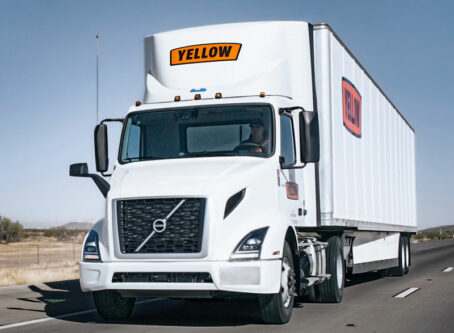A rail strike looms. Again.
Editor’s note: On the afternoon of Dec. 1, the Senate passed legislation to avoid the strike. That legislation has been sent to President Joe Biden to be signed into law. The legislation does not include paid sick leave, a sticking point for unions and dissenting lawmakers. Biden promises to continue working toward paid sick leave “for all workers,” according to remarks made during a news conference earlier in the day.
Here we go again. For the second time this year, we’re on the brink of a national freight railroad strike.
A rail strike would overwhelm trucking. Shippers would be looking for motor carriers to handle more than 38,000 rail intermodal containers a day. That doesn’t include the bulk commodities that move almost exclusively by rail. The sheer volume might swamp all the tankers and grain trailers in the country even if they weren’t already busy.
Drawn-out negotiations between railroad companies and unions had sputtered on from 2020 until July of this year, when the unions finally voted to strike. Then, with some muscular persuasion by the Biden administration, an agreement was reached. A strike was averted.
But four of the 12 unions involved failed to ratify the agreement, and those unions will be free to strike on Dec. 9, the end of the latest official cooling off period. If that happens, the other unions would probably honor their picket lines. A strike by even one of those unions would probably result in a total freight rail shutdown.
Congress is unlikely to let that happen. The House of Representatives passed a resolution to impose the tentative deal reached in September. Senate passage is likely but not entirely assured. The politics involved would fill another couple of blog posts.
In any case, the Biden administration supports imposing the contract, and so do the railroads and many business organizations.
“A strike would be unthinkable as there is a long history of forced legislation to avoid such an event occurring,” said Dean Croke, principal industry analyst at Denver-based DAT Freight & Analytics in an email.
The big issue?
But some union officials have reportedly asked lawmakers to stay out of the dispute. Their members are mad. Paid time off seems to be the big issue. But there’s more to it than that.
Too few workers and punishing schedules are the larger underlying issues. Understaffed railroads require workers to be on-call for work on short notice. When a crew returns from a trip that can be days long, it’s put on a list of available crews. The fewer workers available, the shorter the list. A crew can be called back to work at virtually any time. Train crews don’t get consistent weekends or days off, and taking unauthorized time off can result in firing. One union representative said it was time to stop the rail management “from firing people for being sick.”
How serious are the unions?
Consider what the dissenting unions have turned down. The proposed five-year contract includes a 24% overall pay increase over five years, including a more than 14% increase immediately. According to the National Railway Labor Conference, the railroad negotiating group, “average rail worker wages will reach about $110,000 per year by the end of the agreement. When health care, retirement, and other benefits are considered, the value of rail employees’ total compensation package, which already ranks among the highest in the nation, would average about $160,000 per year.”
Since the last contract expired in 2020, and terms of the proposed agreement are retroactive. If the new contract goes into effect, rail workers will get an immediate payout that will average $11,000.
Never mind the broad pay increases, can you imagine voting against a contract that would put a check for $11,000 in your hands in the months just before the holidays? That’s exactly what four unions did.
Drawn-out rumblings
It should not have surprised anyone. One of those unions had voted to strike back in July by an astounding majority of 99%, though the sheer size of the proposed settlement may have tempered strike fervor somewhat. The largest union to reject the contract did so by a margin of 51% to 49%.
Nevertheless, the contract rejection stands. Some people speculate that should Congress enforce the contract, many rail workers will simply quit.
“There’s a good chance the holdout unions agree to disagree with some/many members taking their two years’ back pay and leaving the industry. That’s what I’d be watching in the new year,” said DAT’s Croke.
Meanwhile, the railroads that brought on the continuing staffing crisis by aggressively eliminating workers are proposing another reduction. They want to lower the current crew requirement of two workers per train down to one – presumably an engineer. U.S. freight trains average one and a half miles in length. Some are up to three miles long.
Railroad management called out
Martin Oberman, chairman of the federal Surface Transportation Board recently called out the largest railroads for policies that have led to the current turmoil. The STB watches out for shippers’ interests, and shippers are very unhappy.
Oberman spoke at a mid-November conference sponsored by Progressive Railroading, a publisher that declined to share a transcript of his comments. An STB spokesman said the agency didn’t have a transcript, adding that the chairman likes to speak more or less off the cuff.
But Oberman’s comments were reported in FreightWaves by John Kingston. According to Kingston, Oberman pointed out that “between January 2016 and February 2020, Class I railroads reduced their workforces by 29,000 workers.” That meant the rail companies had no “cushion and resilience to respond to inevitable disruptions.”
By the start of 2022, Oberman said, the level of service by the big rail companies had “fallen off a cliff.” Faced with too few workers to handle the freight, the big railroads had to embargo certain shippers. In other words, they stiffed their customers.
“One customer needed to euthanize ‘millions’ of chickens because it couldn’t get them to market, and ethanol plants reported to the STB numerous short-term shutdowns because there were no railcars to get product to market,” Kingston wrote.
“It is beyond question that the service problems were the result of intentional drops in the workforce,” Oberman said.
“Today the railroads tell us they are still having a hard time recruiting and retaining workers and try to blame this on the ‘Great Resignation,’” Oberman said. “The fact is the railroad’s personnel practices made these jobs much less desirable.”
Of course, trucking knows a little about undesirable jobs.
Oberman’s STB lacks the power of its predecessor, the Interstate Commerce Commission that once ruled over virtually every detail of both rail and trucking operations. But it was refreshing to read of an official calling out a group of wealthy, powerful companies that screwed up big time.
Trucking could use a voice like that. LL









